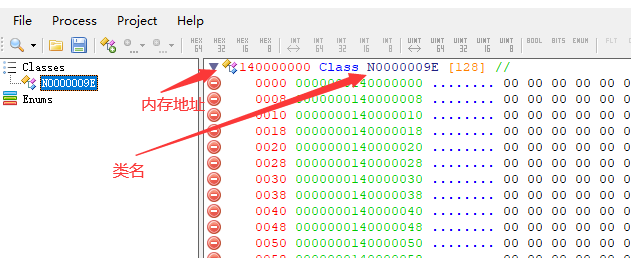# 解析结构
c++ 测试代码
#include <iostream>
using namespace std;
struct MyStruct
{
int a = 1;
const char* cs = "str";
const wchar_t* wcs = L"str2";
} s;
int main()
{
printf("pointer: %lp\n", &s);
cin.get();
return 0;
}
reclass 附加进程 file -> attrch

创建一个class


双击地址设置为c++程序打印的地址,双击类名改为struct

解析类,我们知道a是int
右键第一行选择change type -> int32

设置类型后

下面有4字节对齐的pading,将类型设置为text,大小4字节

剩下两个我们知道是char*和wchar_t*,定义类型后
多余的字节可以使用delete删除掉,字节不够可以右键add bytes
如果你想在c++中使用解析的class 右键 类名 -> show c++ code

复制到你的c++程序使用

# data**
c++
#include <iostream>
using namespace std;
class MyStruct
{
int a = 1;
const char* cs = "str";
const wchar_t* wcs = L"str2";
};
int main()
{
auto* pX = new MyStruct();
auto** ppX = &pX;
printf("pointer: %lp\n", ppX);
cin.get();
return 0;
}

使用CE解析结构

# 数组 1 B* arr[3]
c++
#include <iostream>
using namespace std;
class B { public: size_t i; };
class A { public: B* arr[3]; int a; };
int main()
{
auto* pA = new A;
pA->a = 100;
for (size_t i = 0; i < 3; i++)
{
pA->arr[i] = new B{ i };
}
printf("pointer: %lp\n", pA);
cin.get();
return 0;
}

# 数组 2 B** arr
c++
#include <iostream>
using namespace std;
class B { public: size_t i; };
class A { public: B** arr; int a; };
int main()
{
auto* pA = new A;
pA->a = 100;
B* arr[3];
for (size_t i = 0; i < 3; i++)
arr[i] = new B{ i };
pA->arr = arr;
printf("pointer: %lp\n", pA);
cin.get();
return 0;
}

# 数组 3 B** arr[3]
#include <iostream>
using namespace std;
class B { public: size_t i; };
class A { public: B** arr[3]; int a; };
int main()
{
auto* pA = new A;
pA->a = 100;
B* pB;
B** ppB;
for (size_t i = 0; i < 3; i++)
{
pB = new B{ i };
ppB = (B**)malloc(sizeof(uintptr_t));
memcpy_s(ppB, 8, &pB, 8);
pA->arr[i] = ppB;
}
printf("pointer: %lp\n", pA);
cin.get();
return 0;
}
